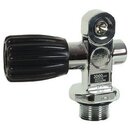Hi
A first timer here ..
I have 2 new Al80 tanks with DIN valve connectors. one of them blows O-rings 10 minutes after I connect my regulator and for safety reasons I can't dive with it.
My dive operator fills it up to 3500psi (245 bars) although it is rated for 3000psi (207bars). Could this be the reason it blows Orings? My other similar tank doesn't do that! The orings are a snag fit and they are from Scobapro dealer, so I'm sure they are to the spec.. Any similar experience? Please help.
Al
A first timer here ..
I have 2 new Al80 tanks with DIN valve connectors. one of them blows O-rings 10 minutes after I connect my regulator and for safety reasons I can't dive with it.
My dive operator fills it up to 3500psi (245 bars) although it is rated for 3000psi (207bars). Could this be the reason it blows Orings? My other similar tank doesn't do that! The orings are a snag fit and they are from Scobapro dealer, so I'm sure they are to the spec.. Any similar experience? Please help.
Al





